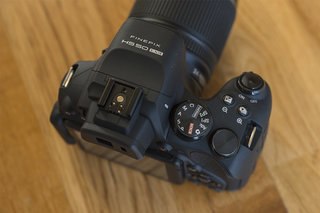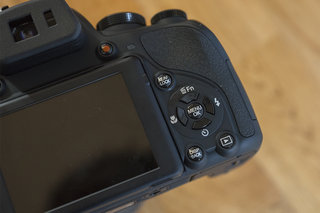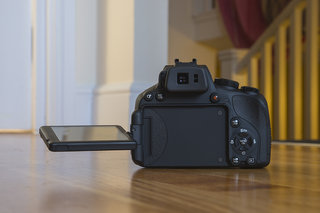Сравнение Fujifilm FinePix HS50EXR и Canon PowerShot SX50 HS
Содержание
Характеристики и результаты тестирования Fujifilm Finepix HS50EXR
| Соотношение цена/качество |
|
| Тип камеры | |
| Максимальное разрешение | |
| Макс. разрешение фото | |
| Макс. разрешение видео | |
| Дисплей: диагональ | |
| Дисплей: разрешение | |
| Дисплей: поворотный | |
| Дисплей: регулировка яркости | |
| Матрица: тип | |
| Матрица: размер | |
| Оптический зум | |
| Минимальное фокусное расстояние | |
| Максимальное фокусное расстояние | |
| Оптический стабилизатор изображения | |
| Диафрагма объектива (Широкий угол — Теле) | |
| Режимы съемки | |
| Панорамный режим съемки | |
| Минимальная выдержка (авто) | |
| Максимальная выдержка (авто) | |
| Минимальная светочувствительность (ISO мин) | |
| Максимальная светочувствительность (ISO макс) | |
| Баланс белого | |
| Разрешение по центру при ISO мин | |
| Разрешение по краям при ISO мин | |
| Разрешение по центру при ISO 400 | |
| Разрешение по краям при ISO 400 | |
| Разрешение по центру при ISO 800 | |
| Разрешение по краям при ISO 800 | |
| Разрешение по центру при ISO 1600 | |
| Разрешение по краям при ISO 1600 | |
| Точность передачи текстуры (Kurtosis) / деталей (Dead Leaves) при ISO мин | |
| Точность передачи текстуры (Kurtosis) / деталей (Dead Leaves) при ISO 400 | |
| Точность передачи текстуры (Kurtosis) / деталей (Dead Leaves) при ISO 800 | |
| Точность передачи текстуры (Kurtosis) / деталей (Dead Leaves) при ISO 1600 | |
| Экспертная оценка: детализация при ISO мин | |
| Экспертная оценка: детализация при ISO 400 | |
| Экспертная оценка: детализация при ISO 800 | |
| Экспертная оценка: детализация при ISO 1600 | |
| Шумность при ISO мин | |
| Шумность при ISO 400 | |
| Шумность при ISO 800 | |
| Шумность при ISO 1600 | |
| Макс. хроматическая аберрация (Широкий угол / теле) | |
| Виньетирование (Широкий угол / теле) | |
| Искажения (Широкий угол / теле) | |
| Форматы изображений | |
| Время включения (до получения первого фото) | |
| Задержка спуска затвора в широкоугольном положении (с автофокусом) | |
| Задержка спуска затвора в телефото (с автофокусом) | |
| Пауза между двумя последовательными кадрами | |
| Скорость серийной съемки в JPEG | |
| Максимальная длина серии в JPEG | |
| Название аккумулятора | |
| Стоимость аккумулятора | |
| Фото на одной зарядке аккумулятора | |
| Видео: макс. время записи на одном заряде аккумулятора | |
| Видео: контейнер | |
| Видео: кодеки | |
| Видео: максимальная длина ролика | |
| Поддерживаемые карты памяти | |
| Встроенный накопитель | |
| Горячий башмак | |
| Приемник GPS | |
| Датчик ориентации | |
| Водонепроницаемый корпус | |
| Габариты | |
| Вес |
Performance tweaks
One thing that’s always riled us about the Fujifilm HS-series is the way that at longer focal lengths the preview feedback «freezes» while the camera thinks its way through autofocus. It means at those longer focal lengths a half depression of the shutter can result in visual silence and the subject may have wandered off before there’s the chance to shoot it. Finally the HS50EXR means that’s no longer the case — it sees performance tweaks from the EXR-CMOS II sensor’s implementation which means it’s far easier to continue tracking a subject at those longer focal distances.

The camera’s autofocus system is still fairly typical of a current superzoom camera despite the inclusion of sensor-level pixels for phase-detection autofocus on the new sensor. Think fast at the widest-angle setting and you’re on the money, but such speed isn’t maintained: it dips incrementally as the zoom extends. At the 1000mm setting, for example, you may find many conditions mean that the camera drifts into focus with a more casual lean on proceedings — it’s not the near-instantaneous results at the 24mm equivalent — but it still delivers results in a decent time frame.
Although the HS50EXR may look a lot like a DSLR, don’t mistake it for one. This is quite apparent with the autofocus system’s layout and versatility: we’re happy with the camera’s response for this class, but it doesn’t offer up multiple positioned focus points on the screen as per a DSLR for example.

That’s not to say that there aren’t a variety of focus option of course, and the HS50EXR does include a multi-area option, albeit one where the camera will automatically decide where to focus rather than the ability to group by area. Much the same can be said about the continuous autofocus mode which lacks the kind of pep to keep up with fast-moving subjects — it’s reasonable, but unquestionably falters.
However we found the the combination of both centre point or the user-positionable area focus types to be more than sufficient to deal with the majority of shooting situations. It’s the aforementioned side-positioned function button that makes it even quicker to make adjustments within this latest model and, considering that it is a superzoom camera and nothing more, it really does deliver.
Close-up focus is also a gem, as at its widest angle setting the macro mode means it’s possible to get right up to the point a subject is almost touched by the lens while maintaining focus. This isn’t sustainable as the zoom extends, but the HS50EXR is still capable of impressively close focus distances as the zoom extends. It’s a definite high point that’s made shooting blossoming trees a treat.

The camera’s built-in electronic viewfinder (EVF) is another decent slice of tech, even if it bares no improvements compared to the HS30EXR predecessor. The 920k-dot panel is just as resolute as the camera’s rear LCD screen, which is about as good as things get at this price point — only, now a little later in its life span, the higher-end Fujifilm X-S1 does offer a better EVF option alongside a larger sensor size at a similar-to-cheaper price point. That, at least to some degree, does throw the HS50EXR’s high price point into some confusion, even if the X-S1 can’t match up to the extensive zoom equivalent.
READ: Fujifilm X-S1 review
It’s the HS50EXR’s mega lens that’s among one of the biggest reasons to consider the camera above other superzooms. But it’s all just a bit plasticky. Using the manual focus ring doesn’t deliver as silky smooth a user experience as we’d like, but we love the presence of the ring-driven focus. If the camera wasn’t on the approach to the £500 price point this would be less of a criticism.

Still, for the money, there’s plenty of extra tech packed in here. The inclusion of optical image stabilisation is something we’ve been banging on about for an age and the HS50EXR finally invests in such tech. Previously it was sensor-based which meant no advantage to what was seen in preview — a real bum note when zooming in to those high triple figures. In the HS50EXR it’s an essential that works well, though at a 1000mm equivalent you’ll need a steady hand and firm hold to make the best of it.
Elsewhere there are only a couple of foibles that grind our gears: the EVF on/off sensitivity is hyper which can cause excessive screen cut ins and outs when a stray finger gets in the way during button presses; and the camera goes into an irretrievable hibernation mode when left on for too long — it’ll need a full off and on motion to fire it back up rather than a quick press of the shutter.
Introduction
The Fujifilm FinePix HS50EXR is a new bridge super-zoom digital compact camera. Looking and handling like a DSLR, the Fujifilm HS50EXR boasts a 42x zoom lens which covers a 35mm equivalent focal range of 24-1000mm and features mechanical image stabilisation and twist-barrel manual zoom and focusing controls. Other highlights of the HS50 EXR include a 16 megapixel ½-inch EXR Back Side Illuminated CMOS sensor, a 3-inch vari-angle 920k-dot LCD monitor, 920k-dot electronic viewfinder with eye-sensor for automatic switching, and full 1080p HD movie recording at up to 60fps with stereo sound. The biggest difference over the previous HS30EXR model is the inclusion of Phase Detection pixels on the sensor to achieve an incredibly short autofocus lag of just 0.05 second in ideal conditions. In addition there’s an ISO range of 100-12800, High Speed movie capture at 480 fps, continuous shooting at 11fps, Focus Peak Highlight function, 500 shot battery life, a customisable Function button, full manual controls and support for the RAW file format. The Fujifilm FinePix HS50EXR is available now for £469.99 / $549.95 in the UK / US respectively.
What else is new
Design-wise there aren’t huge cosmetic changes compared to the HS30EXR model despite the new and longer lens — but we think that’s a good thing. We like that the lens is controlled manually just as before, much like a DSLR lens. A twist of the lens barrel extends to the zoom rather than using the more compact-camera-like zoom rocker of some competitor models. There’s also a manual focus ring tucked behind the extendable lens barrel.

But there are clear differences compared to before, some of which may sound small but collectively add up to a far more advanced camera overall.
The HS50EXR’s LCD screen is mounted on a vari-angle bracket which allows it to be rotated through any number of angles beyond its predecessors vertical-only tilt-angle bracket. There’s also a resolution increase: now with 920k-dots compared to the 460k-dots of before. That 50 per cent jump in resolution does carry through into real world viewing too, and the vari-angle bracket is of genuine use too.
But with the new screen’s bracket to the side of the body means there’s no room for the usual array of buttons to the rear left, and therefore the HS50EXR does embody a new layout. To its side there’s a focus type selector — with single, continuous and manual options — complete with centre function button which can be used to adjust focus point position or magnify the zoom when manual autofocus is selected.

A new «Q» button acts as a quick selection menu that brings up all manner of options in a grid formation on the LCD screen too. It’s easy to hop about and adjust the likes of ISO, white balance, exposure type, and even more detailed settings such as image quality right down to individual noise reduction, tone, colour and sharpness levels.
So it’s not just that stonkin’ great lens, optical image stabilisation system and new sensor that’s new: there are plenty of little extras tucked away into the HS50EXR that make it all the more shiny and attractive than its predecessors.
